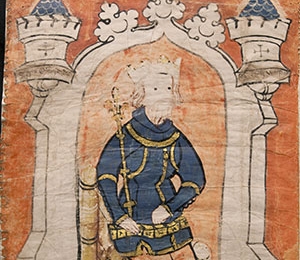John Morice (died 1362) facts for kids
Sir John Morice (died 1362) was an English statesman who worked mostly in Ireland during the 1300s. He is mainly remembered for trying to improve the way the Irish government was run. He also has a portrait that still exists today, which is believed to be the oldest picture of an Irish judge. You can see this portrait in public.
Contents
Early Life and Start of His Career
Sir John Morice was born in Bedfordshire, England. His family were landowners, but they did not have strong political connections. He started his career working for a powerful nobleman named Aymer de Valence, 2nd Earl of Pembroke. Morice worked for him on and off until Pembroke died in 1324.
In 1313, Morice was forgiven for supporting the people who killed Piers Gaveston, a close friend of the King. Later, in 1343, as a high official called the Deputy Justiciar, he helped the citizens of Dublin get the right to collect a special tax. This tax was called "pavage," and it was a fee collected to help pay for paving the streets.
Efforts to Improve the Government
As Justiciar, a top royal official, Sir John Morice was asked by the King to make big changes to the Irish government. Many people had complained that government officials were doing things wrong. The King issued two special rules, called ordinances, in 1341 to guide these changes.
The plan was to:
- Look closely at all parts of the government.
- Investigate claims of officials being dishonest.
- Get rid of government jobs that were not needed.
- Replace Irish civil servants with English people, especially those with wealth and property.
- Collect all money owed to the King right away.
- Take back all lands that the King had given away since 1307. However, the King also promised to pay fair compensation to those who lost their land.
This plan was seen as "unrealistic and impractical." When Morice sent a confusing report about taking back lands, he forgot to mention the promise of compensation. This made the powerful Anglo-Irish ruling class very angry.
Morice was not strong enough to face this organized opposition. He fired many Irish officials, which only left him isolated and the government in disarray. The Parliament of Ireland met in Dublin and Kilkenny and clearly showed they were against the changes. They sent many requests to King Edward III, asking him to stop the reforms.
The King understood how the public felt and quickly canceled the special rules. He then fired most of the Irish government officials. However, Morice himself kept some favor with the King, even though his power was greatly reduced. Some people believed that appointing Morice was a mistake because he lacked strong connections and special talents.
Leading Military Actions
As Justiciar, Sir John Morice was expected to have military skills, but he was not known for them. This led to many harsh comments from the powerful Anglo-Irish nobles. Despite this, he led several military trips. He fought against Irish clans who threatened the peace in an area called the Pale in County Meath. He also fought against the MacMurrough-Kavanagh dynasty, who were Kings of Leinster.
There were also problems with the Anglo-Irish nobility. Sir Risteárd de Tuit, a descendant of early Anglo-Norman settlers, was arrested for acting against the King. A much more powerful enemy, Maurice FitzGerald, 1st Earl of Desmond, was also put in prison for rebellion, and his lands were taken away. Morice was put in charge of these lands. Desmond was later forgiven and got his lands back.
In 1346, Morice, as Deputy Justiciar, helped arrange the release of Maurice FitzGerald, 4th Earl of Kildare. Kildare had been imprisoned because he was suspected of planning with Desmond. In the same year, Morice visited Westminster in England to talk with the King.
In the spring of 1346, the Justiciar, Sir Ralph d'Ufford, became very ill. Morice, his Deputy, was with the King, who sent a message to d'Ufford with instructions. The King added a worrying comment: "if he reaches him alive." Morice likely did not reach d'Ufford before he died in Kilmainham near Dublin on April 9. Morice then became Justiciar for a short time.
In August of that year, the King ordered Morice to question "worthy gentlemen" in County Waterford and County Tipperary. He was to ask about all crimes and wrongdoings committed there. Towards the end of the year, he was called back to England.
His Recall and Later Life
Even though Sir John Morice had good intentions when he came to Ireland, his time as Chancellor or Justiciar was not successful. One historian called him a "second-rate civil servant" who should not have been given such a high position. His handling of the reform program was seen as a complete failure.
A sad letter written by Morice to the English authorities still exists. In it, he complained about disturbances, the high price of food, and how much the public disliked him. He even asked if he was truly allowed to act as Chancellor because his official appointment papers had not arrived.
He was called back to England in 1349 and died there in 1362. He was married twice and had at least one son, also named John.
His Portrait
Sir John Morice is shown in the Waterford Charter Roll from 1372/3. This image is believed to be the earliest portrait of an Irish or English judge. The portrait had a political purpose. Morice had made a decision that supported the special rights of the port of Waterford. The main goal of the Charter Roll was to gain the King's favor for Waterford, especially over New Ross. It also aimed to keep Waterford's status as a royal port, which allowed it to collect tolls. The Charter Roll is now on public display at the Waterford Museum of Treasures.


